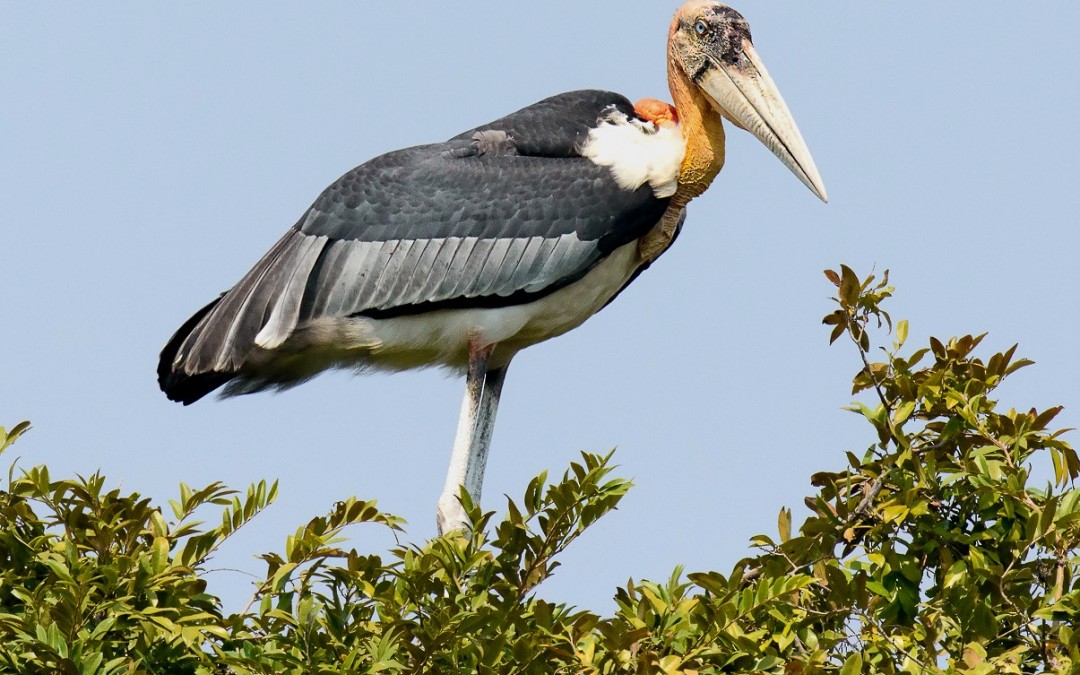
by Nick | Feb 25, 2021 | Blog, Conservation, Kayak, Uncategorized
Prek Toal on finfoot
The incredibly rare milky adjutant lived in Prek Toal and it was my mission to save it even before I got to Cambodia and realized there isn’t a milky adjutant it’s a Milky Stork and a Greater Adjutant. Undeterred enthusiasm intact, Prek Toal was at the heart of why I’d come and where I was going.
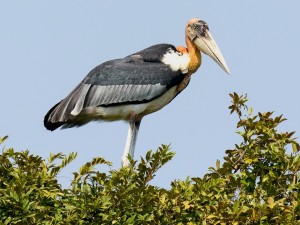 Greater Adjutant inside the Core Bird Reserve.
Greater Adjutant inside the Core Bird Reserve.
The Core Bird Reserve did not disappoint. A two hundred square kilometer water world of open forest emerging from The Lake during the ebb, it seemed untouched and unvisited. A haven for the flocks of large birds that flew past our boat; pelicans soaring high on the thermals or sailing galleon like across the lake. Oriental Darters and cormorants flying in formation, plunging into the water with their spear like beaks to pluck out fish. And the storks perfectly poised in the tree canopy, ruled over by the largest of them all, the Greater Adjutant.
Over 200 species have been recorded inside the core bird reserve so every size, shape and color has adapted to take advantage of the hierarchy in the flooded forest.
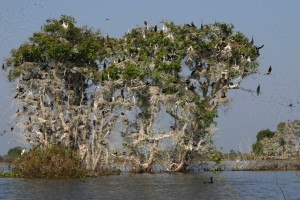 Cormorant and Oriental Darter colony with their white chicks. Photo Nick Butler
Cormorant and Oriental Darter colony with their white chicks. Photo Nick Butler
Prek Toal Village is fantastic in its own right, hundreds of wooden houses floating on clumps of bamboo clustered along the river banks in the dry season when the lake is low or spread out into the forest during the flood. The village economy revolves around fishing; subsistence for the poorer families in the floating shacks. Midscale for those that can afford the apparatus and the bribes to fish inside the core bird reserve. And commercial where migrants work for the Bong Thoms (powerful people) with fishing rights to the Lake. In February the fish fences fringe the flooded forest to trap the fish as they emerge from their sheltered nurseries beneath the trees.
Life on the lake is dictated by the annual pulse of water surging down the Mekong River. Silt caught in the current is carried from China through Myanmar, Thailand and Laos then deposited where the water slows South of Phnom Penh. The raised riverbed changes the direction of the flow from South to the sea now North to the great Tonle Sap Lake, filling it like a bath until the King pulls the plug at Bon Om Teuk, The Water Festival and allows the river to regain its normal route.
 Prek Toal Village during the flood. Photo Nick Butler
Prek Toal Village during the flood. Photo Nick Butler
The flood brings life in the form of fish that swarm into the flooded forests of Prek Toal to breed, spawn and grow providing much of Cambodia’s protein.
What can we say to our guests when we take them across the lake from Siem Reap to The Core Bird Reserve and Prek Toal Village?
We can explain the hydrological phenomena at the heart of the ecosystem and describe the adaptations both human and natural but it’s best to let people see for themselves and watch the wonder of this other worldly place work its magic.
That’s the scene set for our trip with Discovery Magazine onboard finfoot to capture the essence of what makes this place so special. Sally had come to look beautiful. Sam was there to photograph her looking beautiful. Daniel was there to write about her looking beautiful. The Core Bird Reserve and finfoot with logistical assistance from Indochine Exploration was the reason she looked beautiful, and incidentally why I was there.
It’s not easy to take a boat inside the Core Bird reserve but Buntha and Bo had persuaded the conservation team in Prek Toal to let us in. So we sailed through the trees to where Wildlife Conservation Society has built platforms in the canopy to monitor and protect the bird colonies. The water was at its height so we could see the submerged vegetation and the fish that swam between the leaves beneath us. It was too early in the year for the star of the show, the milky adjutant AKA greater but the trees were laden with black and white colonies of darters and cormorants with their creamy white chicks.
We paddled back in our kayaks over the yellow mats of saray, a tiny floating flower to where the water hyacinth clogs the channels into Prek Toal.
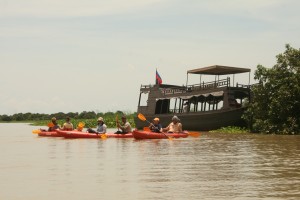 Kayaking at the edge of the Core Bird Reserve from finfoot. Photo Nick Butler
Kayaking at the edge of the Core Bird Reserve from finfoot. Photo Nick Butler
Clearing a route through the weeds we made it to The Sangke River and paddled across to The Saray Platform where the women of the village weave the dried stems of this invasive alien into handicrafts that are sold for the benefit of the poorest families in the village. There’s also a restaurant, you don’t have any choice, its fish fresh from the lake with vegetables and fruit traded from Siem Reap.
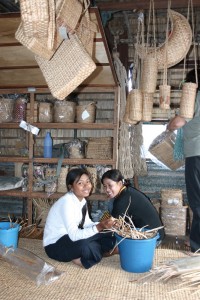

Women from Prek Toal Village weaving the stems of water hyacinth into handicrafts on the Saray Platform. Photo Nick Butler
We were sailing on finfoot, so we forwent the fish and rice in favor of lightly poached chicken and roast vegetable salad back on board.
The kayaks stowed and all aboard we stretched out luxuriously across the day beds on the upper deck, shaded by a canvas awning while the staff laid out our lunch boxes complemented by a chilled Chenin Blanc.
We’d been to the ends of the earth, a forest of flooded trees circled by flocks of birds. We’d paddled through a village untamed by time, as mesmerized by the villagers as they were by us.
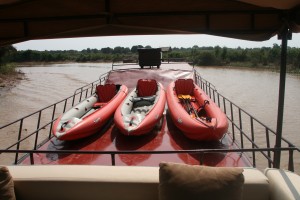 Kayaks stowed on finfoot
Kayaks stowed on finfoot
Indochine Exploration creates a very special day onboard finfoot. The Core Bird Reserve is Indochine Exploration’s flagship adventure, uniquely exploring this pristine environment by kayak with conservation experts.
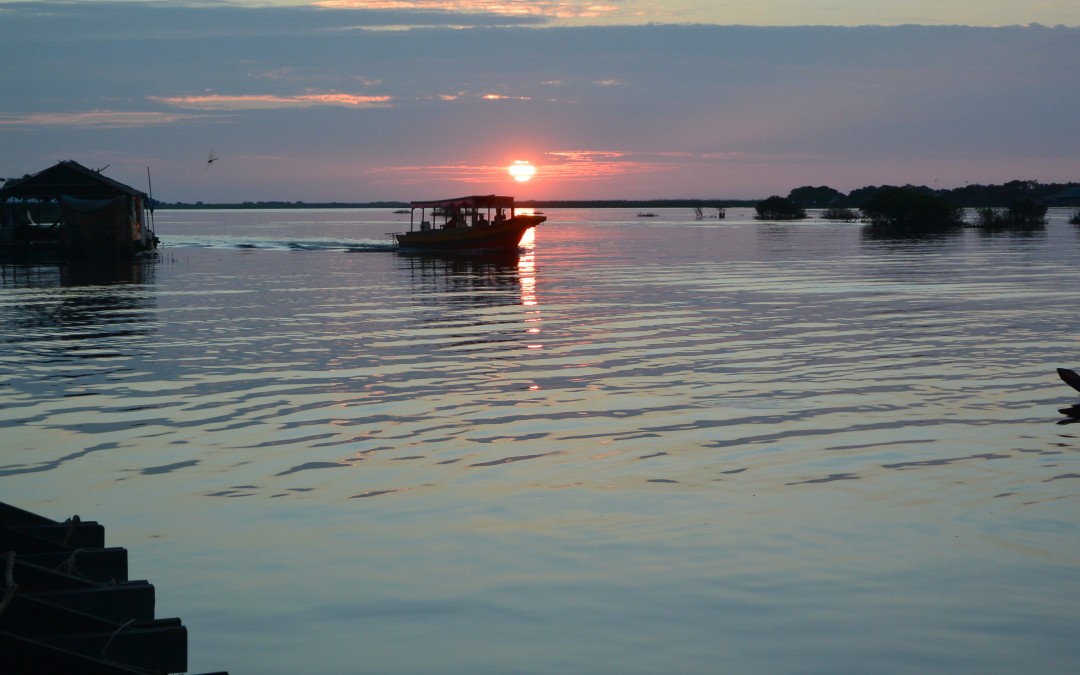
by Nick | Apr 2, 2020 | Blog, Cambodian Journeys, Conservation, Culture, Kayak, Uncategorized
Lena & Seb’s Battambang Adventure
Day 1
Vans, big motorboats, little motorboats, kayaks, bicycles, trains and taxis all had a part to play in our adventure on route from Siem Reap to Battambang. Overnight in the floating village of Prek Toal and the flooded forests of the Core Bird Reserve. Across the floodplains of the Tonle Sap Great Lake and up the Sangke River through the lush rural countryside of Battambang Province to the centre of the farming town in twenty four hours and a bit.
The expedition started at the boat station near Maichrey floating village, where Mr Heang and Finfoot, our comfortably converted fishing boat were waiting. The water was still high enough for us to cross the flooded scrub where we moored to a submerged tree. Lena and Seb were apt pupils as I explained the hydrological phenomena of the Mekong River system until I was rudely interrupted by a virulent green pit viper wrapped around a branch overhanging the deck.
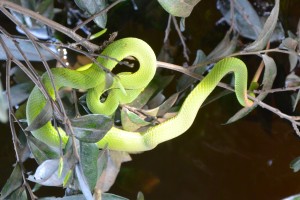 Pit Viper in tree beside boat
Pit Viper in tree beside boat
The afternoons adventure was to explore Prek Toal floating village and the surrounding flooded countryside by kayak. The police chief took photos as we paddled past his station, children came out to stare as we floated by their houses, while those who were working ignored us.
Our improvised route went between the blackened trunks of flooded trees, under their dense green canopy and emerged beside the floating Catholic Church. We crossed the channel to where a muscled boy was ladling fish into piles in front of squatting ladies who chopped them up with meat cleavers, making a pulp that would ferment into Prahoc or Khmer cheese. So named because it stinks.
 Seb and Lena setting off from their homestay
Seb and Lena setting off from their homestay
We watched the sun – a blood red orange, set over the Core Bird Reserve from the watchtower on top of the environmental research station, then motored over to the Saray Platform for supper.
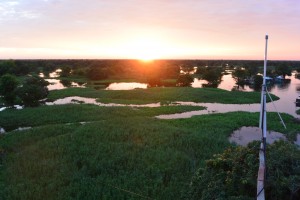 Sunset over the Prek Toal Core Bird reserve
Sunset over the Prek Toal Core Bird reserve
Reflections twisted by the wake of motorboats, a cool breeze playing over the boat’s spume.
Hosing the prahok tables ready for tomorrow. Alien clumps of hyacinth drifting on the water.
Single pin pot lights overly bright in the blackness.
Cotton wool fluff of half seen cloud and the glare of a television set as we came close to people’s houses.
The women weavers on the water hyacinth workshop had gone home but their piers were cooking us a supper of fish, vegetables and fruit with rice and a good bottle of chardonnay to wash it down.
Swinging in a hammock in Veasna’s house our home for the night. Manus hid a lime in Baby Buntha’s nappy. His sister heaved the heavy little lump across the floor. The Mother in Law busied herself with not much. The Grandmother on all fours played with the baby. Little sister went skipping to her mummy then wrapped the baby in plastic, all the while pool hall play by the lads in the village. Hide and seek by the water jar, doubled up Grandmother.
Day 2
Streaky orange lighting the village as the first long tails cacaphonic clatter echoed across the water, the old lady hawked, the batteries ran out on the night lanterns. We awkwardly crossed the tilting boats to the pool hall barge to meet Heang, who took us for breakfast back at the Saray Platform.
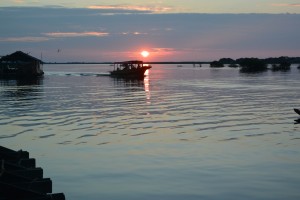 Dawn over Prek Toal
Dawn over Prek Toal
Bunhoeurn was waiting in the community boat for the ride into the magical landscape of the post dawn flooded forest. The light of the warming sun reflected by the delicate yellow flowers of floating saray plants. Squadrons of cormorants flew in slip-stream formation. A profusion of black and white; Oriental darters mixed with egrets, pelicans riding the thermals like galleons in the sky and the bird colonies. Avian cities built in the tallest trees.
Back in the village by 9am our journey into the heart of darkness (actually lush, pastoral Battambang) began.
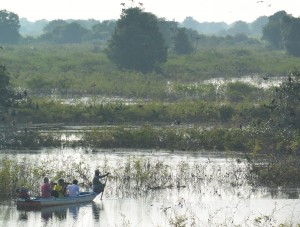
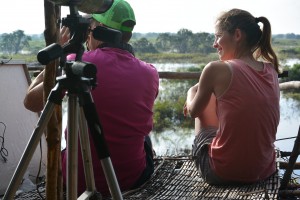
The core bird reserve & view from observation platform
The waterway was fringed by hyacinth and undulating green margins of scrub with the occasional hamlets of floating houses or shacks tied to trees. The first proper village was Kampong Prahoc, which sort of translates into waterside place of good fermented fish paste. I wouldn’t want to be there when the water is low and rotten fish undiluted!
After an hour or so we began to get an idea of how vast the floodplain is. Over 40 kilometres wide where the water rises and falls by 10 meters submerging all but the tallest trees. In the floating villages along our route the only permanent constructions were pagodas on stilts.
Around a bend and Wat Cheu Khmao or temple of the black wood, came into view like a Burmese monastery with a beautiful modern pagoda framed by sugar palms behind. It was built in 1944 copying the Bayon Temple in Angkor and completed with Loksvara, the smiling faces at the cardinal points but they were blamed after accidents and disease struck the village then removed.
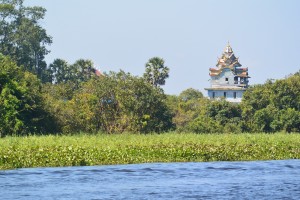 The salapali or space for teaching of Wat Cheu Kmao
The salapali or space for teaching of Wat Cheu Kmao
Great clumps of yellow green bamboo towered over the floating houses. The stems are harvested to provide the floating platforms on which the villages are built.
A regal Grey-headed fish eagle on guard beside its nest in a tall tree, while on a lower branch a hunched up night heron the servile vizier to the magnificent bird above.
We passed a tacky tourist lunch stop as bad as any bus station for the back packers crammed inside and on top of the fibreglass tourist boat.
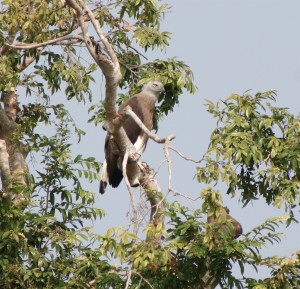 Grey-headed Fish Eagle
Grey-headed Fish Eagle
A single file short cut through the scrub, stopping for long tail boats loaded with beer and rice and wooden boats with giant water jars. We emerged onto an open plain where the trees had been cut down. Home to a transient people living on their small house-boats or shelters on the river bank as the water receded. Strange pivoting bamboo fishing nets were lowered into the water then raised revealing a whicker basket tied to the bottom to trap the fish.
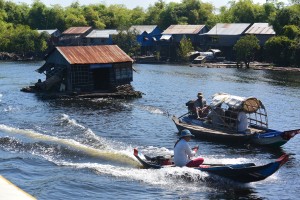 A floating house being towed to deeper water through a village of stilted houses
A floating house being towed to deeper water through a village of stilted houses
A fat pelican sat on the porch of a floating house. An unhappy monkey ran around on a chain in the full sun on a bamboo fishing platform and a full grown otter seemed ok as it scampered round the girl who held it’s leash.
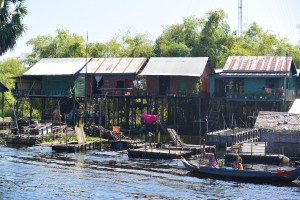 The stilted houses lining the still flooded banks of the middle Sangke River
The stilted houses lining the still flooded banks of the middle Sangke River
Telephone masts were visible in the distance. Riverbanks rose above the water and motorbikes parked beside houses. We’d reached the upper Sangke.
Beautifully painted pagodas in stark contrast to Cham mosques. Elegant stilted wooden houses with tiled roofs between sugar palm and kapok trees.
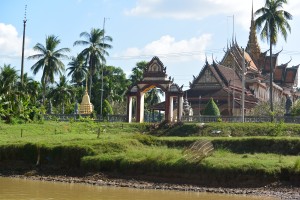 A pagoda on the riverbank not far from Battambang
A pagoda on the riverbank not far from Battambang
Lena and Sebastian safely delivered to their garden enclave in Phum Wat Kor upstream of the town, I breathed a sigh of relief as the extra hot, double shot latte created by Chenda was placed on the little wooden table in front of me at Knyei Cafe.
Twice cooked beef with Seb and Lena at Jaan Bai cooking school restaurant then Jamesons and bed.
Weddingitis had infected the town and the Seng Hout Hotel where we’d booked to stay had a particularly virulent attack so we kept on going to find another bland box like building with half the Cardamon Forest used to make the furniture but ice cool rooms with no aesthetic distractions to sleep.
Day 3 The Battambang bicycle tour of the city with San.
First stop gold, bras, wigs, fruit, meat & fish, the crammed Psa Thmei or new market, built by the French.
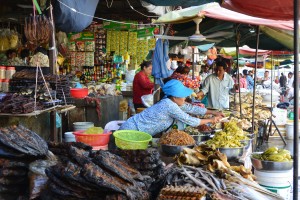 Psa Thmei
Psa Thmei
We crossed the quayside and down the dry banks to the ferry man who took us across the river to the monk school at Bovil Pagoda.
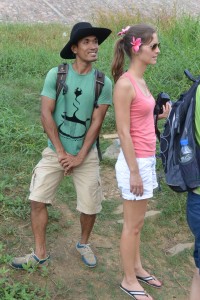
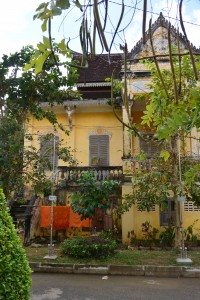 Manus & Lena crossing the river and a monk house at Bovil Pagoda
Manus & Lena crossing the river and a monk house at Bovil Pagoda
Singing rang out from the Catholic Church, which had the enthusiasm of an American black baptist congregation not the stilted formality of a Catholic communion. Time was getting short and the Bamboo Train beckoned so we had to forgo the black man in the middle of the road, another of Battambang’s attractions.
Giant wood spiders had weaved their webs over the rail tracks. The view extended across bright green rice fields to Phnom (hill) Sampeou in the distance.
A one-way system, lift off the bamboo platform, remove the axles and let the oncoming norrie through before putting it back together again.
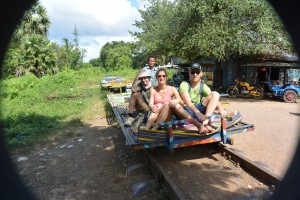 Nick (left), Lena & Sebastian on board a norrie
Nick (left), Lena & Sebastian on board a norrie
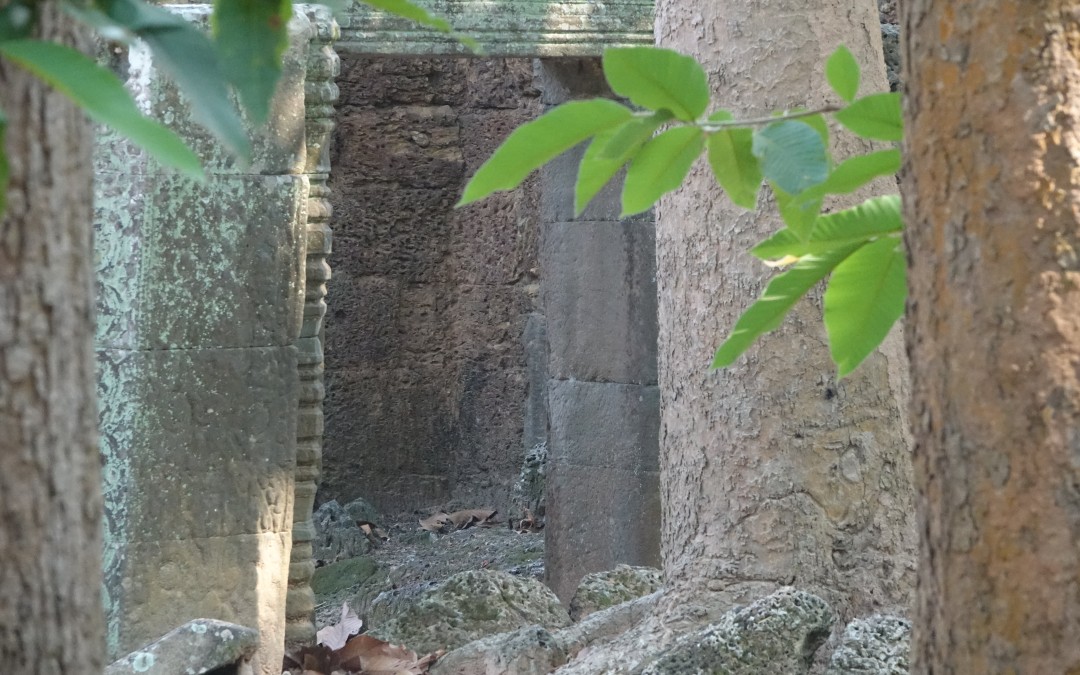
by Nick | Jan 29, 2020 | Angkor, Uncategorized
The Dry Season Temple Hunting Jeep Safari
We travel in reverse chronological order starting with 2 temples from the Bayon period.
The Buddhist king Jayavarman VII (or JVII for short) crammed into his thirty year rule the largest building program ever undertaken during the Angkorian era. At the center of his empire was the city of Angkor Thom and his state temple the Bayon.
Not far from the North Gate of Angkor Thom, off a red earth road and down a sandy track is Prasat Chan Ta Oun, once upon a time a Buddhist monastery.
 The central tower of Chan Ta Oun
The central tower of Chan Ta Oun
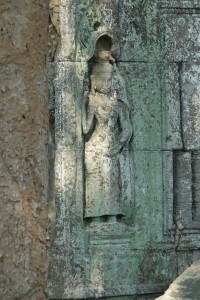 A divine figure from Buddhist mythology
A divine figure from Buddhist mythology
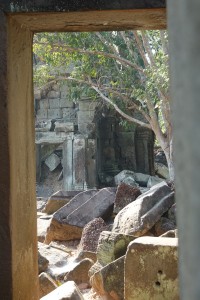 looking into the inner enclosure of Banteay Thom
looking into the inner enclosure of Banteay Thom
Banteay Thom also close to Angkor Thom* is built on a larger scale and harder to find, which is part of it’s charm.
*Thom being the Khmer word for big and Prasat means temple
There are two laterite walls with a moat in between and an entrance from the East. The inner enclosure is surrounded by galleries that can still be entered but not recommended for arachnophobes.
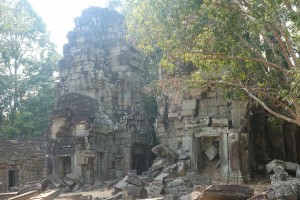 The central towers of Banteay Thom
The central towers of Banteay Thom
The three central towers that have been dug out for treasure are looked on by carvings of Buddha in his Bodhisvatta state of enlightenment.
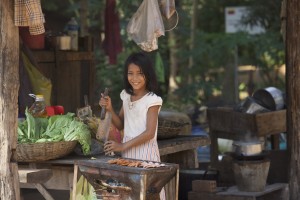 Phum Char (or Char Village)
Phum Char (or Char Village)
Small roads through stilted villages in countryside not much changed since the temples we visit were built. We’ll stop on our way to have a wander through and learn a little about what life is life in rural Cambodia.
We head back in time 200 years and along a red earth road to find Prasat Char (lit. temple of the palm tree) commissioned by Jayavarman V. There are clues as to its construction from the Sanskrit engravings in the stone doorframe.
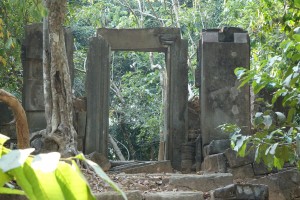 Prasat Char
Prasat Char
An uncertain fate is said to befall the translator as a five-headed dragon awaits those who understand the meaning of these runes.

Another 200 years back in time and we’re swapping the Angkorians for the preceding Chenla period when the Hindu brick temple of Prasat Kok Po was first built. ‘The Island Temple’ appears just that, set on a rise and surrounded by a rainy season moat.
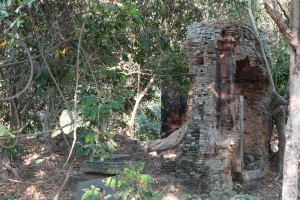 Prasat Kok Po
Prasat Kok Po
Restored by JIII in the 9th century as detailed in further Sanskrit engravings but this time with no dragons involved.
Spean Memay or Bridge of the mirror now crosses a dry field but once it lead from the North West corner of the close by West Baray, and headed to the Western borders of the Empire in Thailand.
 Spean Memay
Spean Memay
The bridge 79 meters in length and made up of 29 arches built in the 12th century survived Typhoon Ketsana, which washed away many modern bridges in 2009.
From Spean Memay we drive up onto the banks of The 11th century West Baray, which at 8km long and 2km wide was until the industrial revolution the world’s largest entirely man made reservoir.
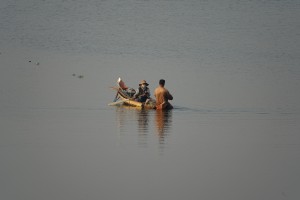 The West Baray
The West Baray
A permanent body of water that is still used to irrigate the rice fields to the South and Siem Reap’s beach resort. The traditional Sunday pass time for the family is to lie on a bamboo platform overlooking the water, drinking beer and gnawing BBQ’d chicken.
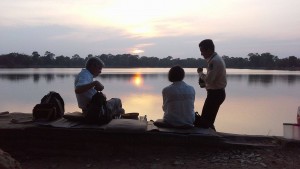
We’ll finish our temple hunting with a picnic lunch or a cold beer looking out across the water to the forests of Angkor behind.
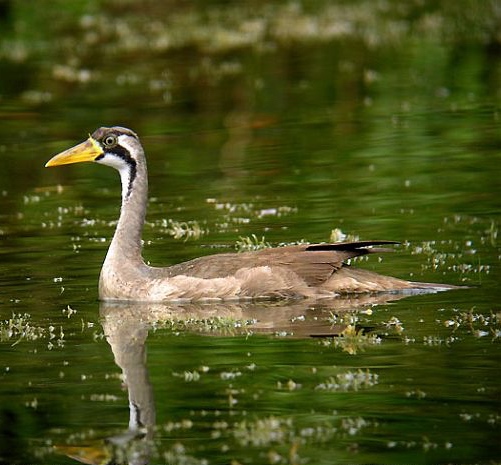
by Nick | Feb 22, 2019 | Blog, Cambodian Journeys, Kayak, Uncategorized
finfoot
1. The finfoot is Hatched
finfoot was born in Prek Toal and conceived in the myriad of marshy waterways that come and go with the flood and ebb of the lake across the floodplain.
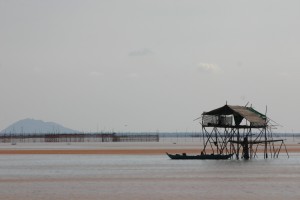
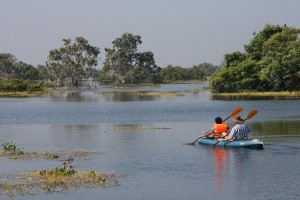 The Tonle Sap Lake during the ebb and Prek Toal Core Bird Reserve (below)
The Tonle Sap Lake during the ebb and Prek Toal Core Bird Reserve (below)
The Masked finfoot is a shy and reclusive water bird skulking in the marshy vegetation lining rivers and lakes. Spotting the bird is a rare and wonderful experience, which seemed a good enough reason to call our boat finfoot (masked is too difficult to pronounce).
 Early morning egrets in the Core Bird Reserve
Early morning egrets in the Core Bird Reserve
I came to Cambodia as a volunteer business advisor to a French NGO. The aim was to provide alternative livelihoods for the families we were working with on the lake. One of these livelihoods was ecotourism but they hadn’t got any guides, hence my first encounter as a bird guide with The Tonle Sap Lake and Prek Toal Core Bird Reserve.
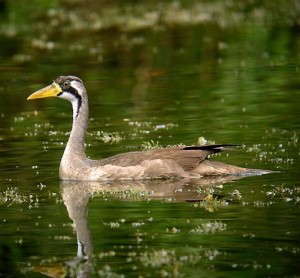 Masked Finfoot Hellopais personatus
Masked Finfoot Hellopais personatus
I didn’t know anything about either but was overwhelmed by the spectacle of the place.
Years spent in Cambodia passed by but my love affair with the lake remained. The phenomenal change driven by the backflow from the Mekong River was maybe reminiscent of the massive tidal zone around Jersey where I’d spent my childhood holidays. The extent of the lake and its inaccessibility, but not if I had a boat!
We’d got something to go on. The uber luxury resort Amansara had a boat called Amanbala. She was the brainchild of Sally the GM and a friend, so not to be copied while she was here but now she’s long gone, fair game.
We started with a wooden hull that seemed enormous and a rusting tangle of metal passing as an engine. It had towed a wedding platform from Prek Toal to the mouth of the fishing channel that leads to Maichrey when we staged the Bill Bensley Boat Races.
The message from our Thai business partners was full steam ahead, just put a business proposal together. So Buntha and I set off for Prek Toal. Buntha’s brother in law, the BiL, in more prosperous times had been a fish merchant as well as crocodile farmer. Moored behind his house was the hull. Once a container for transporting fish across the lake to Chong Khneas where some of the cargo made it to Thailand or Vietnam, while the rest rotted back to where it came from.
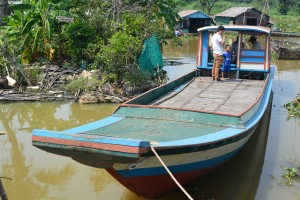 finfoot as it was behind the BiL’s house
finfoot as it was behind the BiL’s house
The BiL connected a big battery to the engine, turned a key beside the Camry steering wheel and the machine roared to life. We nosed round the Chheang collection of floating houses into the main channel. The boat was steered by ropes connected to a long tailed propeller shaft that slowly shifted it in the desired direction. There was no cover or sound proofing but the powerful sound of the big V6 engine was infinitely preferable to the minding numbing cacophony of the 2 strokes that drove the fiberglass long-tails screaming through the village.
Safely away from where our wake could do no more than shake a floating carpet of vegetation, the BiL pushed forward the throttle and the boat took off! The distant lake rapidly loomed large as we almost planed towards it. Two tons of solid wood doesn’t exactly lend itself to planing. The fuel gauge if we’d had one would have been spinning as litres of diesel exploded in the cylinders.
That was last year – 2017, when the lake reached its zenith. This year – 2018, as the water and our guests receded my focus returned to the boat. I put the requested proposal together for our business partners and waited for the green light but after umpteen revisions the light went orange and finally nothing at all.
The dry season window was evaporating when the boat builder could work all day, and most important the next tourist season looming.
I was back in the UK and weary with the sound of my own enthusiasm coming to nothing so the project stalled. Skip a month to Menorca, a weekend away with Laura an industry friend and her pal Duncan. ‘Tell us about your boat,’ they said so I did. ‘We’ll give you 25% – each.’ Ok so the projects incubating. ‘I will too,’ said my brother and the egg was on its way. Another investor in Siem Reap had agreed to 25% but that was talk so the last share became mine.
‘Buntha what’s happening with the boat?’ Was nearly the first question I asked when I got off the airplane from the UK, ‘nothing Bong,’ ‘well let’s make it happen.’ So we did. Mr fixit AKA Buntha found the boat builder at the tourist port of Chong Khneas, who’d built the Amanbala for Amansara.
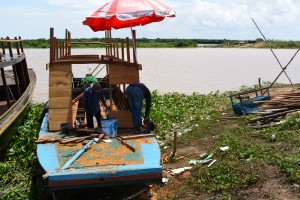
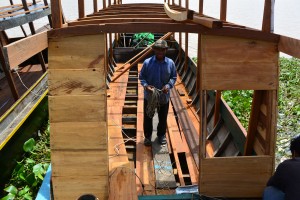

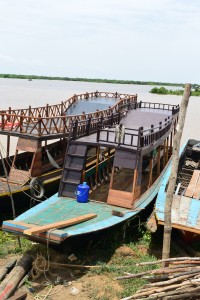 The metamorphosis of finfoot
The metamorphosis of finfoot
We forced our way through the tourist port, ‘not come here,’ the check point charlie ordered. ‘I’m not a tourist, I’m having a boat built.’ My Khmer didn’t cut any ice, I was white and therefor a tourist. I sat and glowered at him until the boat builder fetched me to see what would become a finfoot. We agreed a price, paid him something to show we were serious and that was actually that. Weekly visits to watch the metamorphosis of the bare wooden bones into finfoot went incredibly smoothly such that within a couple of months she was born.
2. finfoot flies
Our Team together with Joni, the GM of Treeline, friend and witness went to Chong Khneas as apparent tourists. Well that’s how Joni & I appeared, the rest are Khmer. We were herded down the gangplank onto the boarding platform and whichever tourist boat and disinterested driver we were to be allocated with. ‘We have a boat,’ I dismissed some tout having spied Heang our captain and finfoot moored and ready, then with a huge surge of pride stepped onboard.
finfoot powered across the floodplain with its big six cylinder lorry engine. Out on the open lake I took the wheel, opened the throttle and felt a surge of oomph. There was still another 30% to go. Our direction towards the forest was slightly disconcerting, I thought as I tried with no effect to correct it. Heang you’d better takeover, I suggested. It steers a little to the right. ‘Yes Bong,’ as if to say that’s why I’m the captain.

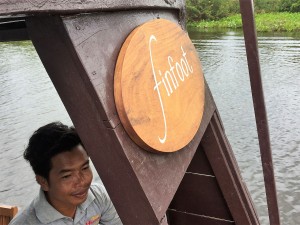 My efforts as Captain and Heang correcting them
My efforts as Captain and Heang correcting them
We moored at the mouth of the Maichrey channel, opened a bottle or two of Prosecco and took self-congratulatory photos.
The Team felt good and on the way back Lors was trying to engage Joni with the usual Khmer chat up line of why aren’t you married, not known for its subtlety. Grasping that the approach wasn’t going well he changed the subject. ‘How do you spell biopsy Nick?’ Sadly his mum had a breast tumor. Tiger grinning, ‘how do you spell f – – – Nick?’ ‘Not sure Tiger, ask Joni,’ even Lors laughed.
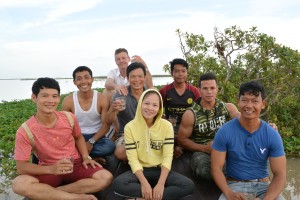 The Team (left to right) Bunthy, Tiger, Me, Buntha, Sreymom, Heang, Lors & Ra
The Team (left to right) Bunthy, Tiger, Me, Buntha, Sreymom, Heang, Lors & Ra
I wanted a space where Dean our partner in cocktails and canapés could work his magic so I commissioned Oyen the cabinetmaker to make a bar with an inset sink behind. Dean had to see it so just before setting off to the UK, Dean & Buntha together with Tiger & I launched our kayaks behind Phnom Kraum and paddled 10km to where the Maichrey Boat Station should be.

Deans bar
It started this year with a dam across the Mekong collapsing in Laos just North of the border with Cambodia. The surge of water that flooded down the river kicked off the backflow up the Tonle Sap River, which in turn flows into the Tonle Sap Lake. Heavy monsoonal rains filled the tributaries adding to the tsunami of water that was swelling the lake near to where it had risen in 2011. We glided across what was and soon will be again the semi-swampy floodplain straight to the boat station except the road was now flooded and the tourist boats were moored in the grounds of the local pagoda, usually a kilometer away. Tiger reappeared with a cold beer, my hero then the van bearing our guests and Dean’s cocktails arrived.
 Naida’s IPhone photograph of the lake as we headed back to the pagoda
Naida’s IPhone photograph of the lake as we headed back to the pagoda
Moored behind a semi-submerged tree, we finished Dean’s cocktails as the sun sank through strata of cloud. Then Naida and the boys moved onto neat gin. We’d run out of tonic.
3. The final fit-out
Yes, yes, yes, said the fabric lady, when I explained that we wanted her unsightly but protective plastic curtains rolled up and wrapped in our beige canvas. The result was reminiscent of a 1970’s B&B in Aberystwyth and I should know, I’d lived in one! We’d also commissioned a canopy for the top deck to shade the mattresses she was going to make. The canopy remained elusive and the mattresses bore no relation to the space where they were to fit. She the fabric lady had sent someone to fit it all out but I don’t think they could count and I had to pay for the changes as she’d got our material that we’d sourced from Australia.
Meanwhile Oyen the cabinetmaker had finished everything he said he would by the time he said, though his daybed collapsed when he sat on it (he quickly came back to fix it). A ships wheel not the steering wheel of a Toyota Camry, the usual method of changing direction for most boats on the lake. I’d managed to find one at a ships chandler in Newhaven, Sussex along with the LED lights we needed for our sunset cocktail trips.
October last year I was back in the UK having one of our weekly Skype calls with Buntha. ‘Bong I’ve got good news and bad,’ or words to that effect. ‘Yes?’ ‘Well which?’ ‘Bad news,’ ‘the engines broke,’ ‘go on,’ I said, just in case you’ve lost the thread of this conversation. As soon as the subject gets technical English ceases to be an effective vector for communication. ‘So what’s plan B?’ I asked. One of the great things about Buntha is he has plan B’s. ‘I’m going on holiday.’ He didn’t actually say that but that’s what happened. He and the mechanic first went to Battambang no luck then to Phnom Penh. Bingo they got the required widget, something to do with the gearbox, and returned. Widget cost $250, traveling costs $250, fixed engine priceless and $900 cheaper than the ‘Bong it’s going to cost $1500.
4. Finfoot adventures
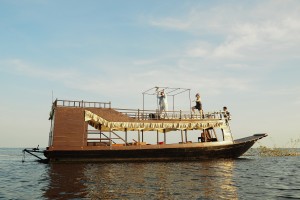
Stephanie and Jules from Bangkok together with Manus & I photographed by Serey and spoiled by frilly curtains
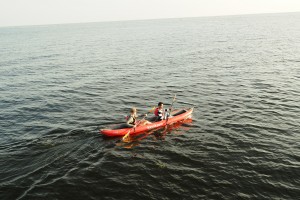

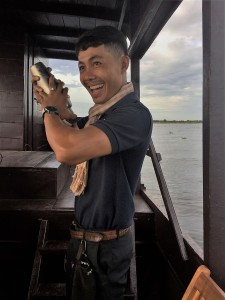 Christian + partner with Tommy on the top deck while Tiger mixes martinis by the bar
Christian + partner with Tommy on the top deck while Tiger mixes martinis by the bar
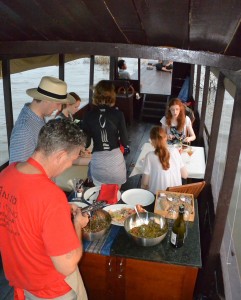 Christmas eve BBQ on board (you can just notice the correct curtains)
Christmas eve BBQ on board (you can just notice the correct curtains)
Our finfoot adventures had been piling up since that happy day we set off on our maiden voyage. It had been a hard week, the constant stress of our impending Smexit (a legal separation from our business partners) and a whole host of other obstacles real or imagined. We needed an excuse to get out of the office.
Manus uncharacteristically turned up on time so we; Buntha, Ra, Lors, Jin and Tiger with Manus set off to recce a big gay wedding party booked for next month.
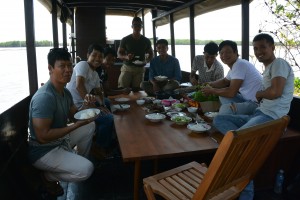 Left to right; Ra, Tiger, Heang, Lors, Jin, Doitch (our van driver), Buntha and Manus
Left to right; Ra, Tiger, Heang, Lors, Jin, Doitch (our van driver), Buntha and Manus
The context was Bill Bensley’s Boat Races in 2013 https://indochineex.com/blog/bill-bensley-boat-races-indochine-exploration
We had towed a wedding platform 15km from Prek Toal to Maichrey. His staff raced traditional water festival racing boats, while our muscle boys, ten of them including Manus, paddled Bill’s inner circle between the racing boats. A photo of Little Tee (left in 2013) and his biceps sold the trip this time so a newly married gay couple will use us to set up a party, with muscle boys on a platform at the edge of the lake.
The issue was the platform we’d used before had sunk when they drove a Caterpillar earthmover on it, so our mission today was to find another one. A job for the Sisters of Mercy and their volleyball court, unfortunately it was holding up the school, which wouldalso sink if we towed it away. Buntha had yet to come up with plan B.
Lors had a chicken smoking on the BBQ, Ra laid the table, Tiger took his shirt off, Jin blended into the background, Buntha sorted out the Sisters of Mercy while I relaxed with Manus and thought about our next adventure, a night on the lake with Manus on finfoot.
‘I want to sleep on the boat,’ Manus told me, and so did I but customers got in the way until the staff lunch.
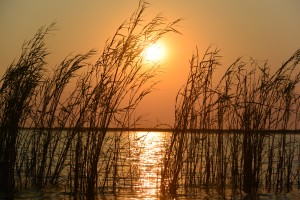
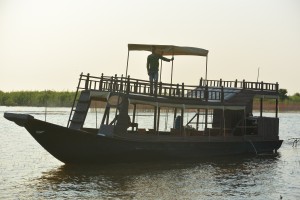 Sunset on The Tonle Sap Lake
Sunset on The Tonle Sap Lake
Upstairs or downstairs was the question. Cool with a view was the answer until I thought about falling off when I need to piss in the middle of the night so we strung up a mosquito net above the downstairs daybed.
Our rival operator as in David and Goliath, where we play the role of David, had kindly constructed and conveniently situated a small platform where the Maichrey Channel meets the Tonle Sap Lake.
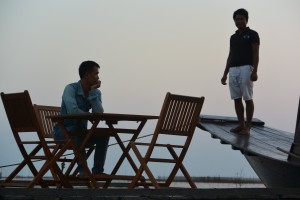 Manus on Goliath’s platform and Heang on the prow of finfoot
Manus on Goliath’s platform and Heang on the prow of finfoot
Heang moored finfoot alongside and I set off in a kayak to watch the sun sink into the Lake. The fishing season has started so the lakeshore is fringed with a maze of fishing nets designed to catch fish, not kayaks presumably. It was a puzzle how to avoid being funneled towards the trap where the unfortunate fish end their life’s journey.A few weeks ago quiet would have settled on the still waters as the sun sank now the staccato clap of 2 stroke engines reverberated as the fishing boys took watch.
A golden path lead from the West to finfoot and our platform for the night, where Manus had a set up a table and chairs. Heang was cooking. I’d forgotten any oil so he was braising our chicken in Cambodia beer, in the meantime I’d bought a bottle of champagne.
 February sunrise over the Lake
February sunrise over the Lake
Heang and Manus sat on the platform as dusk descended and I popped the cork on a bottle of Moet. Manus likes champagne and so unfortunately did Heang, which meant there was a little too much sharing and not enough beer afterwards because it had been poured on the chicken!
It was cool so Manus and I curled up together. The precautionary Valium induced a soothing torpor little penetrated by the predawn clatter of fishing boats. Manus sweetly bought me a mug of tea when I woke and we watched the sunrise through the fishing fences from the East.
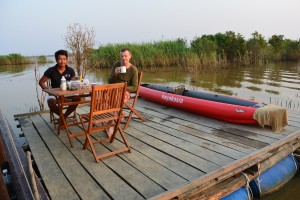 Breakfast on the Lake
Breakfast on the Lake
A couple of coffee’s later we reluctantly headed back. We’d missed the sweet spot when the lake’s high and the fishermen are back in the village mending their nets but it was still a beautiful experience.
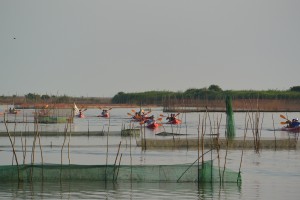
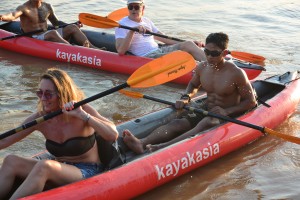
Philip and Stefan’s wedding party a couple of weeks later amongst the fishing fences and Mali the muscle boy with one of the guests
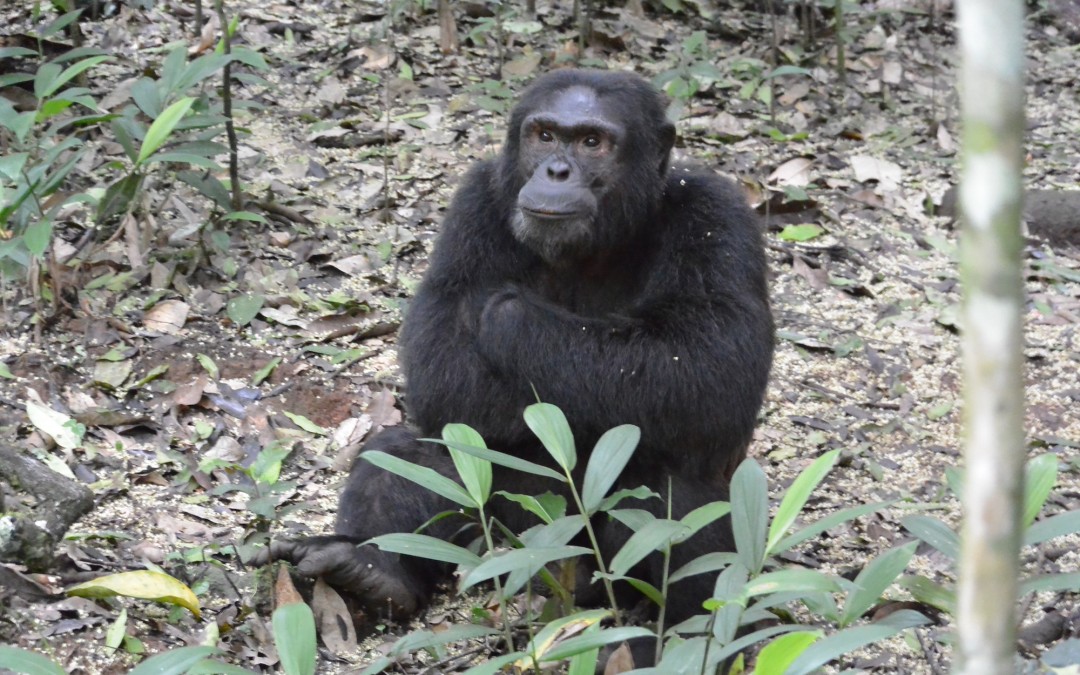
by Nick | Jul 15, 2018 | Blog, Conservation, Uncategorized
A Rwenzori Ramble
Uganda April 2018
Summary
Saturday 28th Depart London
Sunday 29th Arrive Nairobi and onward flight to Entebbe
Tuesday 1st May Fly to Kahihi and drive to The Ndali Lodge
Wednesday 2nd Chimp tracking Kibale Forest & Bird watching Bigodi Wetland
Thursday 3rd Morning drive to Kyambura Gorge Lodge and afternoon game drive in Queen Elizabeth National Park
Friday 4th Morning Chimp tracking in Kyambura Gorge and afternoon boat ride on Kazinga Channel
Saturday 5th Ishasha Forest game drive then transfer to Buhoma and Bwindi Lodge
Sunday 6th Walk to falls – birding in Bwindi Impenetrable Forest
Monday 7th Bird watching in Bwindi Impenetrable Forest
Tuesday 8th Drive to Kasese airstrip, flight to Entebbe then on to Nairobi
Wednesday 9th Nairobi – London
Friday 27th – Sunday 29th LHR 1755 KQ101 2J Arrive NRB 0430
‘You’re late,’ ‘No I’m not,’ ‘Laura said you’d be here at 4,’ Sally told me.
Since I’d orchestrated a hire car drop off, a Southern Rail journey – perhaps the most miraculous, lunch with Laura, an internet booked gym session then the tube to Charing Cross, I was a little affronted. Heyho it wasn’t finished yet, we had the Circle Line to navigate – destination the Barbican for Stravinski’s Right of Spring and followed by Rackmaninof.
The intelligent audience of nice looking people appeared to hear Stravinski as I might hear Hey Jude by The Beatles, I couldn’t translate. Rackmaninof was more approachable so when the pianists started shaking their shaggy heads and raising their hands above the keyboard I was with them.
As with Little Red Fox in Siem Reap for domestic adventures so it was with the Sky Team Lounge at T4 for the African adventure upon which I was about to embark “A Ramble in The Rwenzori”. I had been to see gorillas in Virunga last year (land of a thousand lakes – or was it hills – blog).
The supply of champagne was a touch on the parsimonious side and of course I got there too early but seat 2J wasn’t exactly slumming it. Willy Wonker and The Chocolate Factory was a moral tale with a gruesome ending for the revolting children or should have been except that Rohl Dahl and the directors took the soft option of having the horrible children and their ghastly parents resurrected. Of course Willy (not the wonker) wins because he’s modest, principled, polite and above all cute. The food was shit but better with Moses on the Embrauer to Entebbe and they had more champagne.
0655 KQ410 2A – ENT 0815, The Boma
 The Boma in Entebbe
The Boma in Entebbe
I have a dread fear of queues and forgot my hat. East African airports have lovely air-bridges but they don’t use them so when we had to squeeze on an airport bus all men are created equal and being last off the plane because I forgot my hat, meant the front of the queue for immigration. Oh God my yellow fever certificate – back of queue. ‘E-visas this line,’ front of queue, the immigration officer walks away – back of queue. It didn’t take long and my bag was off first.
The faded salmon pink Boma Birding Boutique as it should be known, was not too perfect and generally lovely.
There’s a lot of people in Uganda and even more birds. I haven’t really been trying but they keep sitting and singing in front of me. Hornbills, weaver-birds (little vandals shredding leaves). Bulbuls, thrushes and finchy things I didn’t spot for long enough to identify. Ibis stabbed at the lawn, pied crows called raucously, black carrion kites soared. And then there was the Botanical Gardens beside the sea, well Lake Victoria but as good as. Egrets, cormorants, darters, pied kingfishers hunted along the waterline and rubbish birds or Maribou Storks scavenged in the park (adjutants in Cambodia).
Sweet Heart Coffee in the Victoria Mall – it reminded me of my early Cambodian assignations with Catrina on our escapes to Phnom Penh. I had a double latte, perfect timing as my legs felt like lead. It even has a gym – it will be part of the cultural experience to try it out.
Monday 30th
I’m not going at 7am! They haven’t bothered to find out where I am so I stamped my feet and spat the trolley out with the pram. Actually it’s mainly because I like Entebbe and wouldn’t mind staying longer.
 Hadada Ibis on the shores of Lake Victoria
Hadada Ibis on the shores of Lake Victoria
An alarm bird, Fred told me is the local name for the weavers, penetrated my Valium induced coma briefly then I fell asleep again until my phone started ringing from somewhere under the bed sheets. I fumbled my way into consciousness slightly resentful of waking up until I realized I’d been asleep for ten hours and should feel good so I did.
It was bugging me. It sounded a bit like a hornbill, that sort of size but the beak was too small. It looked like a thickset magpie but according to my book, which is pretty thick, there aren’t any. I’d seen it eat fruit so the beak wasn’t a raptor’s, a coucal? nearly, an Eastern-grey Plantain Eater. The other species that had been bugging me was the brilliant crimson chested Black-headed Gonolek but it’s about the shape not the colour.
Prior to sweet heart coffee I’d noticed a gym. Two nights with little sleep, a nine hour alcohol fuelled flight/s then a long stroll round Entebbe meant it didn’t appeal yesterday but today was different.
Cameron was a UN helicopter pilot working in Southern Sudan and staying at the Boma. He drops food parcels on people’s heads if the isn’t planned well. There’s some big UN aircraft on the apron at the airport. He’d worked in PNG so lunch went quick such that I was late for Fred my bicycle guide.
Right said Fred – I had to get that in, ‘we’re going to cycle to the reptile farm, visit a homestay, the local town center, the ferry then back to the guesthouse.’ Fred’s 22, studying accountancy, works freelance for Bike2go and has no money as he kept, I’m sure truthfully reminding me. He’s lean, good looking and doesn’t smell much.
Fred told me about the church and the Chams – Muslims. He didn’t tell me about the government, which told me more though others later in the adventure did. His life, he’d split up from his girlfriend but had a ‘target’ in site. Dating, sex, marriage all ok but not to be gay.
Simon showed us round the SNCC a snake farm. It wasn’t a farm but a conservation project. Simon cared for his snakes and animals. He gave the tortoises calcium shots to help them repair their shells. As usual the snakes are an easy scapegoat and get beaten to death if caught unless the conservation message has got through, are still alive and somebody can be bothered to bring them to the conservation center. ‘The first bite they don’t inject venom, so its only when they keep getting abused that people get poisoned’ said Simon.
 Tortoise with damaged shell at SNCC (+ me)
Tortoise with damaged shell at SNCC (+ me)
The SNCC abutted the massive marsh I’d seen from the air. Simon told me it was inhabited by otters, duiker, snakes, etc but now could be reclaimed. Like the Botanic Gardens, where I could see the chunks that had been munched out for development.
Lake Victoria is vast. Arguably the largest lake in the world, of course the Americans claim that Lake Superior is bigger but Fred thinks they didn’t measure it properly.
Actually it wasn’t Fred. ‘Do you mind if I answer the question?’ A polite bystander enquired, compare that to Cambodia where a conversation is common property. ‘Where is Lake Victoria?’ I asked, which seemed like a stupid question as Entebbe is surrounded by it. He pointed in the direction of some storks (black open-bill) and pelicans to where a speedboat was heading out on the nine hour journey to Tanzania.
 Chameleon on Fred’s arm
Chameleon on Fred’s arm
Tuesday 1st May ENT 1245 – Kahihi 1435, Ndali Lodge
Whisky in the tea hadn’t been a good idea, nice at the time but the next morning not so good as I contemplated the idea of getting up. ‘Was breakfast nice?’ Not very, I thought but said ‘alright thanks,’ which resulted in an awkward silence. Bugger the rain, I said to myself and got on a boda-boda back to the gym in Victoria Mall under an innovative umbrella that was positioned such that the motorbike taxi didn’t turn over at 40km.
The baby out with the bathwater had worked. George or Simon dropped me off at the airport. I wandered vaguely in the direction of where I thought the airplanes should be and met a lady who took me to meet a menacing security guard who sniffed my bag.
 Simon flying us to Kahihi
Simon flying us to Kahihi
Next stop a less menacing security man who wasn’t worried about my shoes, watch or belt. The lady said goodbye and George or Simon took me to a little bus, which sped across the Tarmac to my own Cessna Caravan where I met Simon and George who were going to fly the three of us to Kahihi.
It was a stunning flight. At 5000ft we flew under the clouds and dodged the weather systems I could see on the radar in front of me. Lake Victoria to the left and guess what Lake George ahead. A few buffets, a right turn for the final approach, a bumpy landing on the grass strip then we taxied to the little hut where I was laboriously but politely registered. Reassuringly a Volcano Safari’s Landrover was parked with Francis my driver and guide waiting. He appeared a clone of Robert the Rwandan guide last year. At least Francis knew his birds.
 The landing strip at Kahihi
The landing strip at Kahihi
‘Why’s Ndali special?’ I asked Robert, I mean Francis. Special its jaw dropping! Aubrey and his clan own a thousand acres around a crater lake with views from the lodge to villages lining the rim and the lush mat of indigenous trees gripping the soil together on the steep hillsides. Looming above us to the West were The Rwenzori or Mountains of the Moon rising to over 5000m. So called because the early colonialists thought they were tall enough to touch the moon.
 Ndali Lodge
Ndali Lodge
About my own age the couple on the table at lunch had been in Uganda for thirty years and had a farm also a house in Kilkenny. They’d come to Ndali to talk with Aubrey the owner about growing vanilla. ‘Who was he?’ I asked Simon the GM. ‘Dr Ian he has a hospital.’ Later I learnt he was Ian Black a Ugandan citizen, newspaper columnist and former Mayor of Kampala.
At breakfast that morning I’d met a lady who’s husband protects a national park in the DRC the size of Wales (they’re always the size of Wales), home to 47 giraffe at risk from Sudanese poachers who shoot them for their tails to be used as flywhisks. They also prevent the poaching of 1300 elephants.
 Crater lake to the East
Crater lake to the East
‘Three hours to walk round the lake,’ said Francis but Simon (maybe George) and I took one hour.
My own plane, my own lodge – there’s no one else staying here, a candelabra with flickering candles on the table, William the barman and Grace the waitress. An overload of experience which is more than I can process tonight.
 Holub’s Golden Weaver – seen walking around the crater lakes
Holub’s Golden Weaver – seen walking around the crater lakes
Wednesday 2nd Chimp tracking in Kibale Forest & bird watching in the Bigodi Wetland
I eyeballed two species of monkey today. First Totti who wasn’t giving anything away and stared back with distant black eyes, then a Red Colobus looking at me from a branch above. Human like but at the same time unsettlingly alien. Endemic to Uganda they like rotten fruit, which ferments in their stomachs. They get drunk and pick a fight with the chimpanzees who eat them. The chimps were the main attraction but more on them in a minute.
 Crater lake to the West
Crater lake to the West
The clocks are about an hour out in Uganda, great because I’m still writing this outside at 7pm when the equator is just a 100km to the South. It does mean that the wakeup tea was delivered in pitch darkness and breakfast taken with the East door open to let in the light. My table was positioned to watch the sunrise but it was late this morning and Francis and I were on the road before the sun was up.
Subsistence agriculture shapes a diverse landscape. A patchwork of small fields surrounded by useful trees and shrubs. It’s not quite as intense as Rwanda but most contours are farmed. Cambodia the land where the bong thoms* roam is increasingly agri-industrialised leading to endless horizons of uniformity. The pockets of subsistence farming left are picturesque but it wasn’t a one sided story. There were ring barked trees and the intensity of agriculture and diversity of landscape could only happen because of the soils fertility.
*kindly described as influential politicians and business people
Kibale Forest; mysterious, magical and full of fantastic life. An African-grey Parrot flew in front of the Landrover. We stopped to watch Olive Baboons. There’s thirteen species of primate marooned in this enclave of biodiversity previously connected with the great jungles of The Congo.
We had to walk. Francis told me it was a short distance but three hours later we were still going. Bosco our guide who identified birds from calls I didn’t even hear (assuming he wasn’t making it up) and another couple from Chile. The first sign of a chimpanzee was a mound of poo, ‘they’ve got diarrhea.’ ‘It’s a Scaly-breasted Eradopsis,’ Bosco said. ‘Is it painful?’ Finally black bundles in the treetops then a crash as one descended and ran along the path where I was standing. Totti the alpha male 55 kg of muscle chasing Tifu, his ‘target’.
 Totti, the alpha male
Totti, the alpha male
We followed fast behind attempting to snatch a photo on the run, ‘keep going until they sit,’ said Bosco so we ran until Totti sat. The violence and drama temporarily dispelled as he sat in quiet contemplation while I anthropomorphized, looking in his black eyes and wondering what he was thinking about. Gorilla like he lay stretched out and scratched his balls (photo below).

Nelson in The Bigodi Wetlands also knew what he was talking about. Within 500m we had ten new species of birds. Bigodi was swamp forest surrounded by maize, tobacco, coffee and cabbages. ‘Does eco-tourism make a difference?’ I meant that with the intensity of the surrounding agriculture does it help to relieve pressure on the small reserve. He said it did. It’s all green but on our left Bigodi and an incredible array of shape and form and on the other a monochromatic uniformity.
 The Bigodi wetlands
The Bigodi wetlands
So many birds but the monkeys were lacking save for some shaking branches. We followed a track into the swamp to see trees festooned with Red Colobus, closely followed by a Grey-cheeked Mangabe. There were Black and White Colobus in the trees at the edge of the farmland, plus the Olive Baboon, Red-tailed Monkey and Chimpanzees we’d seen earlier meant six species of primate today. FYI colobus means missing which makes sense as colobus monkeys only have four fingers with no opposing thumb.


African Open-bill Stork & Black & White Colobus
Thursday 3rd am Transfer to Kyambura Gorge Lodge. pm game drive in Queen Elizabeth National Park
I didn’t think I’d slept well but surfaced from a full-on dream as Nelson knocked with morning tea. Not cold but nice under the covers, I watched the mountains turn a dusty pink. Suzu was lying by my bed, she’d been there all night. A friendly, rangy hound, her sister was outside.
Sleep assumes an even more important role than normal on a holiday like this because of the difference between being able to ride on the wonder of what you see or just being overwhelmed.
 Queen Elizabeth National Park from my banda at Kyambura Lodge
Queen Elizabeth National Park from my banda at Kyambura Lodge
It was downhill all the way as we descended from Ndale back past Kahihi and the strip where we’d landed all those hours ago, crossed the equator, we’re now in the Southern Hemisphere, and entered the Queen Elizabeth National Park (QENP). I thought Francis was joking when he said hippo but sure enough in a wallow beside the road a muddy mound with two eyes stared back. We spotted Kob antelope in the distance, the Ugandan national animal.
Statistics; its 2000 km2 though seemed bigger when we were driving to Bwindi. There are 2000 hippos that weigh up to three tonnes, 140 lions (out of only 400 in the country), leopards, hyenas, chimps, 400 species of birds, etc. and the lodge. I have to pinch myself, first the West and now the East side of the Great African Rift Valley.
My banda is called Brutus and looks out over half of Africa. Et tu Brute, probably a knife in the back from the dance troupe stamping a war dance in reception (a sort of African version of morris dancing) but OTT after the drive.
 Elephant below the lodge
Elephant below the lodge
It’s becoming a spoilt boys obsession to avoid being over pampered or overfed. ‘You only want that?’ like I’d committed a cardinal sin at breakfast when I only ate muesli. My new butler – yes get that, at The Kyambura Lodge wants me to eat and drink so that she’s got something to do. Instead its becoming a mission to avoid Peace – is there something profound here, that’s her name! So looking right and left I furtively closed the door to my banda, and took a small path so I could run undetected.
It seems right is right in Africa, usually I go left but this time right up the hill past a lot of children shouting mzunga, that’s me. Near the top I looked down to two crater lakes and gratifyingly my track connected with the road we’d come on so it was a circular run and right was right.
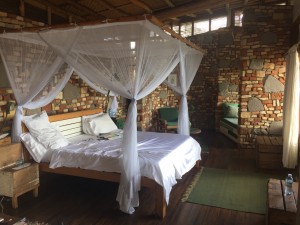 My banda
My banda
Friday 4th am Chimp tracking in Kyambura Gorge. pm Kazinga Channel wildlife from boat
The QENP a vast grassy expanse roamed by elephant bisected and by a slash through the middle bursting with life, The Kyambura Gorge is as unexpected as its magical. One of the most beautiful places I have ever seen.
 The Kyambura Gorge
The Kyambura Gorge
Lazarus or Edward led us with the obligatory gun down a muddy path that descended to a fast flowing brown river. The canopy now high above us enclosed a prime-evil world of snorting hippos and screaming chimps.
The foliage was so thick that we meandered beneath the canopy between tree trunks and hanging vines waiting for our eyes to become accustomed to the gloom.
A few minutes later we saw our first black bundles. The dominant male ran down the tree like it was an airport travelator. He beat the buttress of the trunk like a jungle drum, barred his teeth and screamed violently.
Another male in a distant part of the forest screamed back. Dominance asserted our male lay on the floor, crossed his legs and contemplated the sky.
This time I could see the colour of his eyes, brown in an expressionless face. ‘Do they show emotion?’ I asked Edward. ‘Yes, anger, excitement, pleasure.’
The big male was part of a group that hung around this part of the forest where fruiting fig trees grew. A primates paradise that other chimpanzee groups would like but human encroachment had cut them off resulting in an isolated gene pool. ‘We want to open a genetic corridor with fig trees up and down the gorge connecting the populations.’


 Left and above the Kyambura Gorge Troup
Left and above the Kyambura Gorge Troup
I hadn’t slept well for worrying about unraveling relationships then ‘Good morning, good morning,’ Peace was singing as she bought my morning tea. ‘Oh shut up.’
A Mexican family were staying at the lodge, they’re tour operators, went to Pure in 2017, had an appointment with Smiling Albino and I recognized the two sisters.
Francis’s Landrover, technically mine for the week had broken down, so I went with the Mexicans to the Kazinga Channel. A forty kilometer stretch of water connecting Lake George with Lake Albert, surrounded by the Queen Elizabeth National Park (you’d never know the British had something to do with it).
 The restaurant terrace at the lodge
The restaurant terrace at the lodge
The countryside was dominated by candelabra cactus, invasive aliens that were being knocked down at one site by a CAT. The elephants do it for fun.
The metal tourist boat was a bit of a let down after all the personal pampering but the bird life was prolific. James this time, helped me to identify twenty seven species but it wasn’t just the birds …..


Hippo and Water Buffalo (with Oxpeckers) in the Kazinga Channel
The Yellow-billed Oxpickers were busy stabbing ticks on the back of submerged water buffalo. Massive swirls appeared beside the boat followed by the great grey bulk of hippos, showing off their impressive dental kit and beady, angry eyes.


Residents of the Kazinga Channel, Elephant & African Fish Eagle
A small group of elephant scratched against a Mopani tree and a crocodile tossed a thrashing tilapia in its jaws then swallowed it whole. Warthogs knelt down to graze ‘because they’ve got weak necks,’ James said. Pied Kingfishers were perched on every vantage point and flying into holes in muddy cliffs along the shoreline. They dig to escape the monitor lizards, or it could be the monitor lizards dig holes to catch the Pied Kingfishers. On cue the culprit appeared, a meter long lizard.
At the confluence of the channel and the lake a sandy beach was crowded with plovers, geese, gulls, cormorants, pelicans, Ibis and a dainty hippo grabbing a quick graze before sinking into the support of the soothing water.
A park boundary defined fishing village, allowed because it was there before the park was gazetted, lined a low ridge. My gaze moved to where three young men stood washing themselves in the water. I looked again and saw they were naked, washing each other and er well endowed. ‘Hmm’ I thought, Central Africa’s not totally un-homoerotic.
 Young hippo and water birds along the channel
Young hippo and water birds along the channel
Saturday 5th Ishasha Forest game drive and transfer to Buhoma and Bwindi Lodge
The pastel colours of the park changed. The gorgeous surreal suggestion became reality as I contentedly gazed from the comfort of my large bed sipping Peace’s tea (it was a teabag not proper tea!).
 The Ishasha Forest (there were some more trees)
The Ishasha Forest (there were some more trees)
Driving South for five and a half hours, most of it through the QENP. A vast expanse of empty space with few people, bordered by Lake Edward and the Virunga Mountains, beyond the mysterious and brooding Congo. ‘If Mr Praveen (the owner of Volcano Safaris) opens a lodge I’ll go there,’ I told Francis. Meanwhile UK tourists to the DRC Virunga Park were being kidnapped and ebola’s broken out, I later learnt.
It’s a bird watchers paradise, nearly 400 species in the QENP alone. I’ll list the birds and animals I’ve seen in an appendix to the blog. Vervet monkeys peered out from the undergrowth. The trees were festooned with Black & White Colobus and Olive Baboons roamed the roads.
Hammerkops are undistinguished birds with bad hair. They make up for it by building enormous nests. It’s an obsession.
The tree-climbing lions of Ishasha were out to lunch. They certainly weren’t on any of the horizontal fig tree branches, their usual daytime hangout, that we searched for across the plains in our long wheel based Landrover. We had a picnic beside the Ishasha River joined by snorting hippos then set off for Bwindi, narrowly avoiding mating Kobs. ‘I don’t need Kob porn,’ I told Francis so we left the grassland tracks for the main – dirt – road. And returned to world of humans separated from that of animals by a two meter deep trench.
In the rising mist Bwindi lives up to its name and looks impenetrable. I’m in Bob’s bungalow, that’s the name of the room, looking across the valley at a wall of green as the forest climbs the steep hillside broken only by the trunks of the tallest trees. Gorillas were here this morning. I’ll put out a glass of Sauvingnon in the hope they return. The colobus were content with fermenting fruit and picking fights with the chimps.
Sunday 6th Walk to falls – birding in Bwindi Impenetrable Forest
The breakfast room at the lodge butts out over lawns carved from the forest at the edge of the national park. The staff seemed particularly excited about something then Adolf beckoned me to follow with a conspiratorial smile. A family of gorillas were having breakfast, eating the vegetation in a clearing below the lodge. Transfixed and awestruck I stayed until a park ranger appeared shoeing me away – I didn’t have a $600 pass.
Tropical rainforest with a thirty-meter high canopy, towering giants clad in shrouds of moss and lichen, shafts of sunlight illuminating the delicate fronds of ferns. We followed the lively Munyanga Stream upstream. The lit translation is the grabber. It washes away and grabs the crops along its banks as it flows down to a river.
The source is a spring thirty kilometers up the valley but still inside the park, hence the clarity of the water.
Villagers strolled up and down the path but still we needed two armed guards, no doubt in case of racist elephants. O’Max my guide tried to sell me hiking and tour arrangement in Uganda when I told him I ran a tour company, which has a serious appeal, excepting the gay issue.
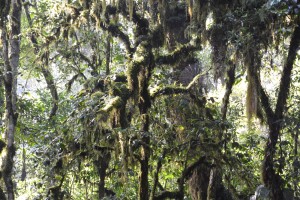 The impenetrable forest
The impenetrable forest
 The Munyanga Stream
The Munyanga Stream
An enchanted path loops below the lodge, down to the river where a trickle of crystal clear water flowed. A bronze coloured duiker (Black Throated) didn’t hear me long enough for me to catch a glimpse. I seem to keep finding naked Africans, men, that is and well endowed. I suppose its because in general the women are large and the men small so they need a large cock to bridge the gap.
‘Pick’ said Fred so Anus and Dorythea decimated a tea bush plucking the top two leaves and central bud as Fred kept reminding Adolf and I, though I don’t suppose Adolf needed reminding as being a butler, mine I later found out, he’d heard it before. The bits of bush were tossed into a basket with large holes so consequently fell out. At a small hut Fred told Anus to use his pestle and grind the leaves to a mush. ‘Fire’ said Fred so Dorythea heated the mush until it was dry. ‘Sieve’ said Fred so Anus sieved it until something approaching tea was collected. Green tea is steamed and not fired. ‘Drink’ said Fred, sorry I mean would you like a cup of tea? ‘Yes please, black,’ it seemed appropriate and was very good.
Adolf made me wake up tea the next morning, ‘where’s the milk?’ ‘Innit,’ said Adolf. It was African tea, ginger, bay leaves, cinnamon and milk, which after I’d got over the surprise was delicious.
Monday 7th Bird watching in Bwindi Impenetrable Forest – day 2
We walked to the border of the park and the DRC, twenty-six kilometers. ‘It’s a long walk,’ said Francis but he hadn’t mentioned 26k. ‘Hmm,’ I thought as he introduced me to Nicholas.
The forest trail is a local highway but we had to have the obligatory two guards and AK47’s. The obligatory two guards realising we were walking to the other side of the park bailed out and had to be replaced.


Flycatcher (above) and sunbird right
Francis had oversold me to Nicholas who thought I was a hard-core fanatic and let loose with his twitching tendencies. Little brown jobs silhouetted in the gloom is not really my kind of bird watching. ‘Its an immature Black Bee Eater,’ said Nicholas as he pointed with his green light saber. ‘The only thing we can agree on is its black and barely indistinguishable from the leaf it’s sitting on,’ I thought.
It started to rain ending any pretensions of bird watching for me, ‘its only another hour,’ said Nicholas. ‘Another hour to what?’ ‘Till we get there,’ ‘what happens then?’ ‘We come back.’ The logic inescapable, the appeal not great but we’d come this far.
The end of the trail was a suspension bridge over the River Ivy. It was like walking on ice unexpectedly so my feet disappeared from under me and slid over the side, luckily I managed to grab onto the bridge. On the other side of the river a grassy valley and a lot of birds having a break from the impenetrable forest.
The biodiversity is phenomenal, apart from the headline species; gorillas, chimps, elephants, colobus monkeys, there’s thirty odd species of endemic birds, some critically endangered of which I saw three. Forty species of endemic butterfly and maybe mammals, Nicholas wasn’t sure. An ancient island cut off from the once vast and still pretty big forests that extended across central Africa and covered all of Congo.
My barely functioning legs felt like lumps of lead as I limped out of the park entrance and made straight to the Bwindi Bar. A couple of Nile Specials and humanity returned.
Four dusky slate blue warblers sat under a yellow flower fluffing up their feathers and preening. Bulbuls hoovered up insects as they rose from the sodden vegetation and the dense forest disappeared as cloud advanced up the valley. Dusk was giving way to night as I wandered my weary way to dinner.
It all started with Rackmaninof & Stravinski, it’s not quite finished yet, where will it end ……….., read on.
Tuesday 8th & Wednesday 9th return Transfer to Kasese 0945 – ENT 1125. ENT 1720 – NRB 1830 KQ415 2A, The Lazizi Premiere NRB 0920 – LHR 1615 KQ100 2A
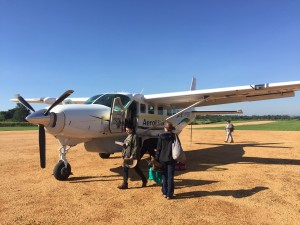 Boarding our Caravan at Kasese with Noemi, the Mexican tour operator
Boarding our Caravan at Kasese with Noemi, the Mexican tour operator
I had a dream, which meant I slept well. Unusually I could remember a little bit, about going into a suspended animation and just as I was about to wake up Adolf woke me with his African tea. It was still black at 6 but a glimmer of light penetrated a quarter of an hour later and by 6.45 I could see the valley.
The weaver-birds are bit like the hammerkops in that they’re obsessed with their nests and fly backwards and forwards carrying tails of grass adding to its construction.
The light was sparkling in the damp from yesterday’s rain, the valley bottom filled with mist and now sunshine bathing the hills on either side. I didn’t want to go. Even Francis and I had become buddies.
The Cessna Caravan landed shortly after we arrived at the Kahihi airstrip and we squeezed in with some Americans, flying back the journey we’d driven down. Over the Ishasha Forest, the plains of the QENP, the Kazinga Channel with the Kyambura Gorge in the distance. Even over the London Bridge imported for the Queen when she opened the Park. Lake George on one side and the Rwenzori on the other as we took off for Entebbe. A full hours flight despite my thinking it couldn’t be much more than a three hour drive. I would have been enjoyable except I needed a piss – badly by the time we got there.
I found a taxi at Entebbe who over-charged me but not badly after we’d bargained a bit, got to the Boma. I had three hours so got changed picked up a boda-boda, went to the Victoria Mall gym for an hour. Had a chilled lunch and spotted yet another species of bird. ‘We’re vegan would you like our garlic bread?’ ‘Of course you are,’ I thought. An American mother and son – or toy boy (I don’t think she was that interesting) asked. I bought a book on mammals at Entebbe airport and watched an enormous Emirates 777 take off.
Totally unnecessary but rather fun, I was the only one at the front of the plane with a glass of champagne safely installed beside my seat. It was like the good old days on the way to Frankfurt when I managed to get in five little bottles of Piper Heidsick before touch down.
It was fitting that the Crowne Plaza at Nairobi Airport was horrible on the last night. I had a burger without the bun, in a bland eating space watching a screen repeat the benefits of the bland hotel. The contrast with exciting lodges on the edge of the wild was absolute.
Work invaded; Tigers pissed off Christian, who knows if we’ve got the JPA school on a BeTreed trip. What Buntha and the rest of the Chheangs are doing is questionable, Manus sent me a nasty message and Own is ill.
And one more species, we’d seen the Crested Crane on the way to Bwindi and a Wooly-necked stork on the way back. A magical place set in a magical country.
Appendix 1. Bird List
Boma
- Hadada Ibis
- Ring-necked Dove
- Eastern Grey Plantain Eater
- Common Bulbul
- African Thrush
- Red-chested Sunbird
- Black-headed Gonolek
- Black-headed Weaver
- Ruppells Long-tailed Starling
- White-browed Robin Chat
Entebbe
- Great White Pelican
- African Open-billed Stork
- Cattle Egret
- Little Egret
- Maribou Stork
- Pied Kingfisher
- Black Kite
- Pied Crow
Kasese
- Black-headed Heron
- Grey-backed Fiscal
- Laughing Dove
Ndali
- Pink-backed Heron
- Cinnamon-chested Bee-eater
- Common Waxbill
- Grey-headed Sparrow
- Ross’s Turaco
- Great-blue Turaco
- Crowned Hornbill
- Pied Wagtail
- Red-billed Firefinch
- African Harrier Hawk
- Holub’s Golden Weaver
Kibale Forest
- Grey Parrot
Bigodi Wetlands
- Black and White Casqued Hornbill
- Copper Sunbird
- Splendid Starling
- Purple-headed Starling
- Woodland Kingfisher
- African Pygmy Kingfisher
- Pin-tailed Whydah
- Black and White Mannikin
- African Blue Flycatcher
- Black and White Shrike Flycatcher
- Bocages Bush-shrike
- Red-headed Malimbe
- Speckled Tinkerbird
- Yellow White-eye
- White-chinned Prinia
- Little Greenbul
- Western Nicator
- Southern-red Bishop
- Tambourine Dove
On route to QENP
- Lizard Buzzard
- Red-eyed Dove
- Yellow-billed Kite
- Long-crested Eagle
- Speckled Mousebird
Kyambura
- African White-backed Vulture
- Vieilott’s Weaver
- Yellow-fronted Canary
- Bronze Sunbird
- Northern-black Flycatcher
- White-headed Saw-wing
- Common Scimitar-bill
- Yellow-chested Sunbird
- White-browed Coucal
- Lesser-striped Swallow
The Gorge
- Grey-headed Kingfisher
- Common Buzzard
- Ring-necked Francolin
Kazinga Channel
- Egyptian / Nile Goose
- Yellow-billed Stork
- Grey Heron
- Spar-winged Lapwing
- Hammerkop
- White-winged Tern
- Yellow-billed Oxpicker
- Black-winged Stilt
- Common Greenshank
- African Skimmer
- Water Thick-knee
- Sacred Ibis
- African Fish-eagle
- Palm-nut Vulture
- Black Crake
- African Jacana
- Yelloueenw-backed Weaver
- Red-throated Bee-eater
- African-wattled Lapwing
- Great-white Egret
- Red Cormorant
- Great Cormorant
- Gull-billed Tern
- Lesser Black-backed Gull
- Grey-headed Gull
QENP
- Helmeted Frankolin
- Red-necked Spur Fowl
- Fork-tailed Drongo
- Arrow-mapped Babbler
- Yellow-throated Long Claw
- Blue-naped Mousebird
- Fan-tailed Widow Bird
- Grey Kestrel
- African Green Pigeon
- Sooty Chat
- Red-rumped Swallow
- Martial Eagle
- Bateleur
- Madagascar Bee-eater
- Flappet Lark
- White Stork
- Rufous-necked Lark
- African Fire-finch
- Grassland Pippit
- Common Sandpiper
- African Grey Hornbill
- Black & White Cuckoo
Around Bwindi
- Auger Buzzard
- Grey Crowned Crane
- Wooly-necked Stork
Bwindi Impenetrable Forest
- Short-tailed Warble (an endemic species and critically endangered not see but heard)
- Mountain Wagtail
- Blue-headed Sunbird (endemic)
- White-tailed Crested Flycatcher
- Yellow-rumped Tinkerbird
- African Blue Flycatcher
- Tiny Sunbird
- African Paradise Flycatcher
- Northern Double Collared Sunbird
- Grey-headed Sunbird
- Olive Sunbird
- Bar-tailed Trogon
- Elliot’s Woodpecker
- Brown-capped Weaver
- Black-crowned Waxbill
- Yellow-fronted Tinkerbird
- Grey-throated Barbet
- Mountain Illadopsis
- White-tailed Ant Thrush
- Equitorial Akalat
- Red-faced Warbler (endemic)
- Olive-green Caneroptera
- Red-tailed Bulbul
- Dusky-blue Flycatcher
Appendix 2. Mammal List
Kibali Forest
- Common Chimpanzee (and Kyambura Gorge)
- Central African Red Colobus
- Olive Baboon (and throughout trip)
- Grey-cheeked Mangabe
- Vervet Monkey (and Bwindi)
- Red-tailed Monkey (and throughout trip)
Bigodi Wetland
- Black & White Colobus (and Bwindi)
QENP
- Ugandan Kob
- Bush Elephant (also Kazinga Channel)
Kazinga Channel
- Common Warthog (and Ishasha Forest)
- Common Hippopotamus (and QENP)
- Cape Buffalo
Bwindi
- L’Hoest’s Monkey
- Mountain Gorilla
- Black-fronted Duiker
by Nick | May 31, 2018 | Angkor, Blog, Uncategorized
Introduction
Angkor is an amazing place. You cannot fail to be impressed even stunned by the grandeur, detail and scale of the monuments. The true wonder of the Angkorian Empire and what it achieved has only started to dawn on me in the last few years. It was when the findings of the Lidar survey surfaced that I grasped the extent of what was one of the world’s greatest civilisations.
Lidar in layman terms emits an electromagnetic pulse i.e. a laser, that is strapped to a helicopter and fired as it passes over the ground to be surveyed. The reflected light is fed through the software that strips away the vegetation to show the topography and reveal previously unidentifiable structures.
The results are phenomenal! Phnom Kulen had a city on top. Angkor Thom was laid out in a grid of roads and canals framing wooden houses and their trapaeng or pools. There were thousands of temples not hundreds, and it was all made possible by the management of water in a climate where at the best of times 6 months of rain is followed by 6 months of drought.
I also began to realise that many of our cycle routes, hiking trails and even kayaking adventures followed these ancient waterways. I’d heard Roland Fletcher give fascinating talks at Amansara and on the banks of the West Baray. It wasn’t until Damian Evans (also from Sydney University) spoke to the guides that I knew he could tell us what we needed to understand Angkor.
The Water Connection
Boeung Ta Neue – our Secret Lake where we kayak, was an Angkorian reservoir formed by an extension of the North Wall of the East Baray, a much larger reservoir connected with the Angkorian cities of Ta Prohm and Angkor Thom. Boeung or lake Ta Neue caught the rain run off from the Kulen Hills to the North, which fed the Baray and in turn the conurbations of Angkor.

Kayaking on Lake Ta Neue
Nearby the corner of the East Baray, where we discovered a wall separating the Baray from Lake Ta Neue, is the 7 arched Spean Tor Bridge. Clearly visible by kayak from the water, we managed to reach it through the bush. We searched on the Baray side for a connection with Lake Ta Neue but none was to be seen. We couldn’t work out the purpose of the bridge though to be sure a thousand years ago it had one.
![]()
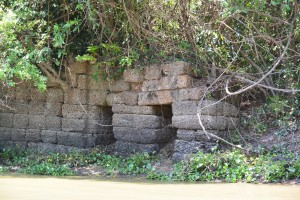
Spean Tor Bridge
The main water flow in and out of the East Baray was through Kral Romeas, a sluice built into the banks of the East Wall. Cycling and hiking through Phum Samre, the village that lines the walls I’d noticed large laterite stone blocks. Closer inspection revealed 1 large thick wall and 30 metres away another running parallel. These formed the sides of the sluice, the raised ground in front of us was a laterite weir. Kral Romeas acted over time as an inlet and outlet to the East Baray and may have been connected by another laterite wall running parallel with the East Bank, to Lake Ta Neue via the bridge Spean Tor.
An outlet has also been discovered opposite in the West Bank at the far end of the Baray, which provided water for the wooden houses between Angkor Thom and fed into the Ta Prohm moat. 7km long and 2km wide the Baray seems to have been a huge body of water to supply what appeared as a compact area of habitation but it would also have been used for irrigation.
Damian put this into context by working out that the 50 million litre3 in the West Baray reservoir of similar size to the East Baray, could provide irrigation for 5000 ha of rice, perhaps 10,000 tonnes for each crop. The rice fed a population of hundreds of thousands of priests, the aristocracy and merchants who lived in and around the ancient temple cities.
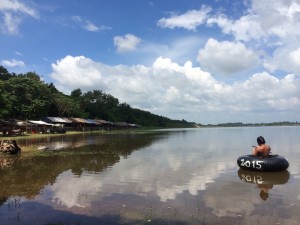
The West Baray at the end of the rainy season
It was also unlikely that the 3 great water reservoirs of the West, East and North Barays were in simultaneous use but acted as a safe-guard for times of drought and flood.
The scale of these man made hydraulics are unparalleled in human history and mind-boggling. To truly understand you have to think about the 3 spatial dimensions in combination with a 4th dimension – time, the chronology of the kings and climate. History seems to have been determined by the weather as the peaks in the empire, first during the reign of Suryavarman II in the 12th century and second under Jayavarman VII in the 13th century coincided with the peaks in rainfall we saw from the ancient records on Damian’s computer screen.
The ultimate decline of Angkor was also linked to periods of extreme drought followed by flood years, which washed away this finely tuned hydrological infrastruture needed to supply water during the dry season and get rid of it during the flood. This is most clearly seen at Spean Thmor near Angkor Thom where the old bridge lies high up the banks of the Siem Reap River, which now runs meters below.
Prasat Tor (prasat meaning temple) and Troung Chruk (pigs temple) it’s ruined sister temple to the South lie between Lake Ta Neue and the East Baray next to an unexplained mystery, a 10 x 10 grid of a 100 mounds.
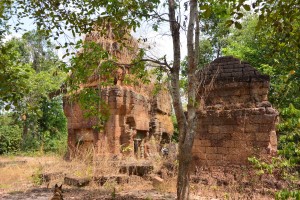
Prasat Tor and it’s 3 laterite towers
Similar grids have been found beside the River of a Thousand Linga’s, Kbal Spean at the West end of Phnom Kulen and Sambor Prei Kup near the modern day city of Kampong Thom, both associated with major water systems. No artifacts or remains have been unearthed to help solve the mystery of what the mounds are.
Walking across where the grids were revealed by Lidar, we spotted fragments of curved roof tiles in a papaya plantation that in an act of unintended vandalism, has been planted right over the mounds, which may help solve the mystery.
Most of what is known about Prasat Tor comes from a 4 sided stele (a stone pillar with carved enscriptions) discovered by the French in the 1930’s and now stored in The Angkor Centre for Conservation. The Sanskrit engravings were translated and available on line, which Damian translated for us in his office that morning. The stele had been installed by a Brahmin priest during the 13th century referring to the Great King Jayavarman VII. The inscription mentions the Ganges River in association with water, which may have had something to do with the Kral Romeas sluice and was the same as an inscription found at Phnom Dai temple to the North, also the site of another grid of mounds. The temple itself appears to predate the stele and may have been built at the same time as the 10th century East Baray.
Randomly cast on the ground around Prasat Tor were the now eroded but once richly carved blocks that adorned the structure including the stone crown that sat atop the central tower. Interestingly it had a hole in the middle, where a bronze finial in the form of a trident could have been positioned. Possibly removed at certain auspicious times of the year to bathe the Goddess Shiva sitting 15 meters below in sunlight.
Now set amongst brilliant green paddy fields in November, on the other side of Lake Ta Neue is Leak Neang Temple dated to the 10th century. A stele has recently been removed from the site to the Angkor Conservation but has yet to be translated.
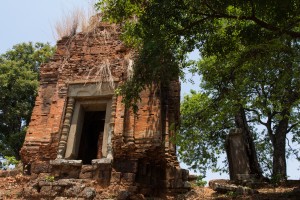
Leak Neang with its single brick tower
The bricks themselves are another mystery as no kiln has ever been found. A theory speculates that the bricks were fired close to the temples then used in it’s construction. The apparent black scorching seen on the walls seemed to support this idea.
Not only was this masterly management of water used to supply The Angkorians and irrigate their crops, it was also conveyed the enormous amount of stone required to build the temples. Laterite is an iron rich clay that is soft and easy to dress into blocks when it comes out of the ground. On exposure to the sun it becomes very hard but relatively light making it ideal for the foundations but not the decoration as its pock-marked surface is not easily carved. The laterite quarries lay in the hills to the West. Dams collected water from streams, which was released into the Great North Channel that carried the stone blocks South to Angkor.
At the Eastern end of the Kulen escarpment were quarries that supplied sandstone, which was carved into the marvelous facades of the temples.
A channel ran from Beng Melea past the Temples of Banteay Ampil and Chau Srey Vibol to Prasat Batchum inside Angkor. A path still connects these sites and makes for a great cycle ride with temple stops for sustenance heading East to the Tamarind Temple – Banteay Ampil.
We were beginning to get a handle on the Eastern end of the water connection, now it was time to explore the Western end. The Siem Reap River flows South from the Kulen Hills to the the city and then onto the Tonle Sap Great Lake but during Angkor it was diverted into the North East corner of the Angkor Thom Moat. History is being repeated as subsequent to the floods of 2011 the channels have been reopened and another dug in parallel on the North side of the moat as the river is diverted into the West Baray with the aim of stopping the floods in Siem Reap. The fact that now the town of Puok to the West floods instead is not part of the discussion – tourists don’t go there.
Angkor Thom was Jayavarman VII’s and his 2 wives, city. The largest of all the Angkorian Cities its wall’s 3km long enclose 9 km2, which is now mainly forest but once housed a thriving metropolis of wooden houses and their trapeang, surrounded by a grid of canals and roads as the Lidar survey revealed.
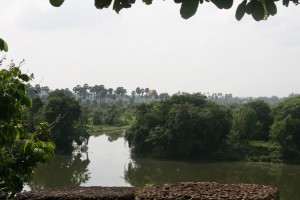
View over the moat from the walls at the S.E corner of Angkor Thom
The data was detailed enough to show the individual houses, which can be extrapolated to give a guessed population of 70,000 based on an assumed family size. This would need a lot of water but during the rainy season any excess flowed out of Boeung Thom reservoir in the South West of the city and through Runta Dev a canal that runs under the city walls into the Angkor Thom moat. We’ve got a stunning cycle route that runs along the 8m high walls of Angkor Thom to Prasat Chrung or corner temple – there’s one at each corner. A great late afternoon spot for watching the sun set over the moat, paddy fields and palm trees beyond. We didn’t realise the engineering marvel that lay 8m below us until Damian lead us down the inner banks to a stream that on closer inspection disappeared into a laterite tunnel under the walls and out to the glinting light of the moat 30m away.
The West Baray 500m to the West is one more mystery. How was this vast body of water replenished and released during times of flood? The current outlet of the Angkor Thom moat is a canal running parallel with the road through the West Gate dug by the French, which destroyed any trace of what was there before. It is possible it was a replacement otherwise how did 50 million litres of water get into The Baray.
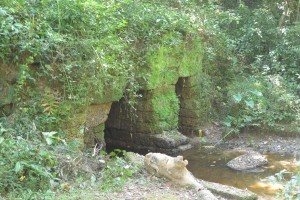
Runta Dev runs under the walls of Angkor Thom
What had we learnt that morning?
We understood that water running off the Kulen Hills to the North fed streams, which flowed into the reservoir / lake of Beoung Ta Neue in turn feeding the East Baray, which was a water supply for the population of Angkor Thom and Ta Prohm.
Damian confirmed that our cycling path to Chau Srei Vibol and on to Banteay Ampil, lay along the route a canal had taken bringing sandstone from the quarries at the Eastern end of the Kulen escarpment via Beng Melea to Angkor.
He explained how the laterite used to build the foundations of the J VII temples were carried by water released into the Great North canal which flowed to the North Baray and Preah Khan.
And the Western hydrological connection was made by the Siem Reap River coming from the Western end of Kulen flowing South into the Angkor Thom moat and maybe on into the West Baray.
And much else besides!
With great thanks to Damian Evans for a really fascinating morning and apologies for any misinterpretations.
Indochine Exploration with Smiling Albino Cambodia is pleased to take our guests on a introductory investigation of the main temples along the water courses described or an adventure to experience this incredible landscape on foot, by bicycle or kayaking.

 Greater Adjutant inside the Core Bird Reserve.
Greater Adjutant inside the Core Bird Reserve.  Cormorant and Oriental Darter colony with their white chicks. Photo Nick Butler
Cormorant and Oriental Darter colony with their white chicks. Photo Nick Butler Prek Toal Village during the flood. Photo Nick Butler
Prek Toal Village during the flood. Photo Nick Butler Kayaking at the edge of the Core Bird Reserve from finfoot. Photo Nick Butler
Kayaking at the edge of the Core Bird Reserve from finfoot. Photo Nick Butler 

 Kayaks stowed on finfoot
Kayaks stowed on finfoot

 Pit Viper in tree beside boat
Pit Viper in tree beside boat Seb and Lena setting off from their homestay
Seb and Lena setting off from their homestay Sunset over the Prek Toal Core Bird reserve
Sunset over the Prek Toal Core Bird reserve Dawn over Prek Toal
Dawn over Prek Toal

 The salapali or space for teaching of Wat Cheu Kmao
The salapali or space for teaching of Wat Cheu Kmao Grey-headed Fish Eagle
Grey-headed Fish Eagle A floating house being towed to deeper water through a village of stilted houses
A floating house being towed to deeper water through a village of stilted houses The stilted houses lining the still flooded banks of the middle Sangke River
The stilted houses lining the still flooded banks of the middle Sangke River A pagoda on the riverbank not far from Battambang
A pagoda on the riverbank not far from Battambang Psa Thmei
Psa Thmei
 Manus & Lena crossing the river and a monk house at Bovil Pagoda
Manus & Lena crossing the river and a monk house at Bovil Pagoda Nick (left), Lena & Sebastian on board a norrie
Nick (left), Lena & Sebastian on board a norrie
 The central tower of Chan Ta Oun
The central tower of Chan Ta Oun A divine figure from Buddhist mythology
A divine figure from Buddhist mythology looking into the inner enclosure of Banteay Thom
looking into the inner enclosure of Banteay Thom The central towers of Banteay Thom
The central towers of Banteay Thom Phum Char (or Char Village)
Phum Char (or Char Village) Prasat Char
Prasat Char
 Prasat Kok Po
Prasat Kok Po Spean Memay
Spean Memay  The West Baray
The West Baray


 The Tonle Sap Lake during the ebb and Prek Toal Core Bird Reserve (below)
The Tonle Sap Lake during the ebb and Prek Toal Core Bird Reserve (below) Early morning egrets in the Core Bird Reserve
Early morning egrets in the Core Bird Reserve Masked Finfoot Hellopais personatus
Masked Finfoot Hellopais personatus finfoot as it was behind the BiL’s house
finfoot as it was behind the BiL’s house


 The metamorphosis of finfoot
The metamorphosis of finfoot
 My efforts as Captain and Heang correcting them
My efforts as Captain and Heang correcting them The Team (left to right) Bunthy, Tiger, Me, Buntha, Sreymom, Heang, Lors & Ra
The Team (left to right) Bunthy, Tiger, Me, Buntha, Sreymom, Heang, Lors & Ra
 Naida’s IPhone photograph of the lake as we headed back to the pagoda
Naida’s IPhone photograph of the lake as we headed back to the pagoda


 Christian + partner with Tommy on the top deck while Tiger mixes martinis by the bar
Christian + partner with Tommy on the top deck while Tiger mixes martinis by the bar Christmas eve BBQ on board (you can just notice the correct curtains)
Christmas eve BBQ on board (you can just notice the correct curtains) Left to right; Ra, Tiger, Heang, Lors, Jin, Doitch (our van driver), Buntha and Manus
Left to right; Ra, Tiger, Heang, Lors, Jin, Doitch (our van driver), Buntha and Manus
 Sunset on The Tonle Sap Lake
Sunset on The Tonle Sap Lake Manus on Goliath’s platform and Heang on the prow of finfoot
Manus on Goliath’s platform and Heang on the prow of finfoot February sunrise over the Lake
February sunrise over the Lake Breakfast on the Lake
Breakfast on the Lake


 The Boma in Entebbe
The Boma in Entebbe Hadada Ibis on the shores of Lake Victoria
Hadada Ibis on the shores of Lake Victoria Tortoise with damaged shell at SNCC (+ me)
Tortoise with damaged shell at SNCC (+ me) Chameleon on Fred’s arm
Chameleon on Fred’s arm Simon flying us to Kahihi
Simon flying us to Kahihi The landing strip at Kahihi
The landing strip at Kahihi Ndali Lodge
Ndali Lodge Crater lake to the East
Crater lake to the East Holub’s Golden Weaver – seen walking around the crater lakes
Holub’s Golden Weaver – seen walking around the crater lakes Crater lake to the West
Crater lake to the West Totti, the alpha male
Totti, the alpha male
 The Bigodi wetlands
The Bigodi wetlands

 Queen Elizabeth National Park from my banda at Kyambura Lodge
Queen Elizabeth National Park from my banda at Kyambura Lodge Elephant below the lodge
Elephant below the lodge  My banda
My banda  The Kyambura Gorge
The Kyambura Gorge

 Left and above the Kyambura Gorge Troup
Left and above the Kyambura Gorge Troup The restaurant terrace at the lodge
The restaurant terrace at the lodge



 Young hippo and water birds along the channel
Young hippo and water birds along the channel The Ishasha Forest (there were some more trees)
The Ishasha Forest (there were some more trees) The impenetrable forest
The impenetrable forest The Munyanga Stream
The Munyanga Stream

 Boarding our Caravan at Kasese with Noemi, the Mexican tour operator
Boarding our Caravan at Kasese with Noemi, the Mexican tour operator





